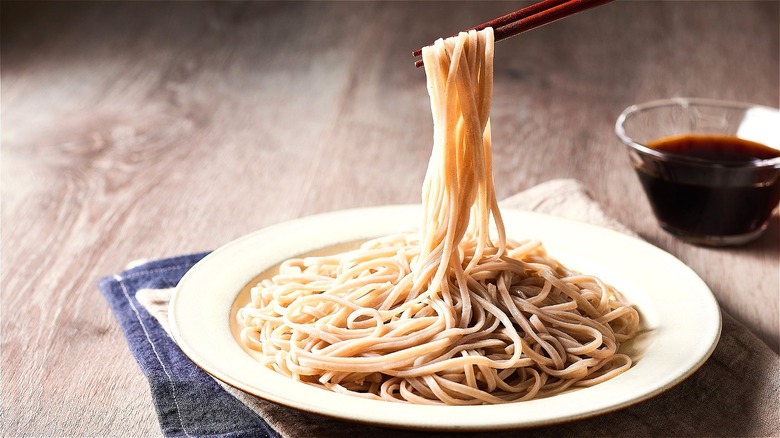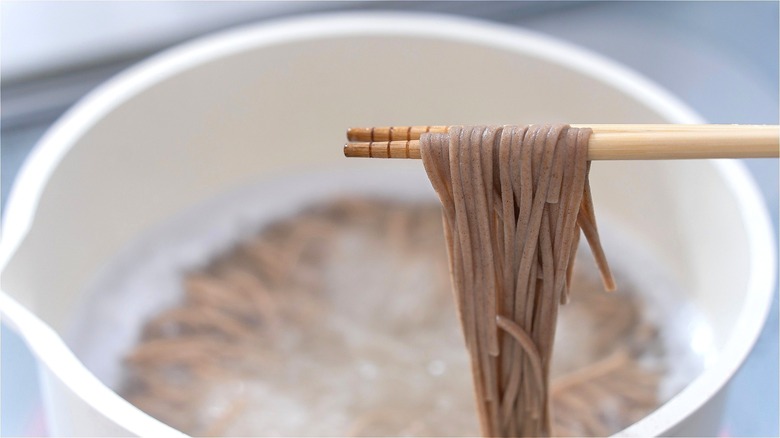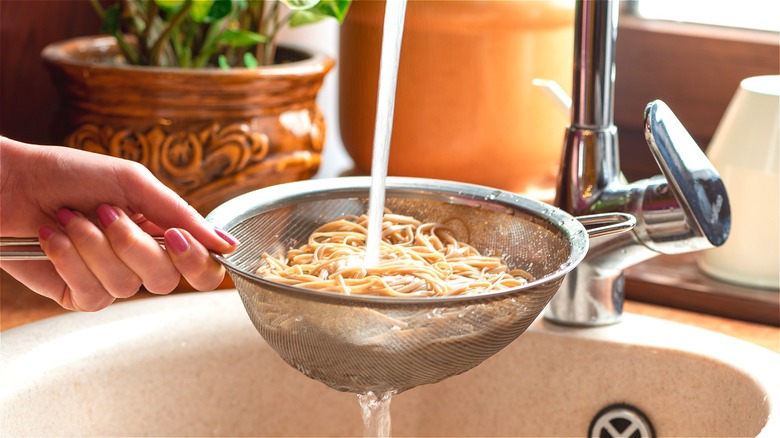Top Tips For Cooking Soba Noodles To Perfection
When you're in the mood for comforting Japanese food, soba noodles are a hearty and satisfying way to fill your stomach. These long spaghetti-like noodles are served both hot and cold and adorn a range of traditionally prepared Asian dishes. Among the various facts you should know about Japanese cuisine, soba noodles are primarily composed of buckwheat flour and water and have a nutty and earthy aroma and taste. Since soba or buckwheat noodles can be difficult to make and prepare without breaking, wheat flour is often added to the base ingredients for extra structure.
Before you venture into making a pot of these hearty noodles for your next evening meal, you might want to learn some of the intricacies that come with preparing soba noodles over your stove. Luckily, Namiko Hirasawa Chen, creator of the popular Japanese food blog Just One Cookbook, gave her expert advice to Daily Meal on how to achieve perfectly cooked soba noodles at home.
When ready to cook, Chen advises boiling noodles in a large pot of water. She states, "Soba is starchy, so boiling in a lot of water helps the noodles cook properly and keeps them from sticking together." Even when you plan on making just one serving of soba noodles, a larger pot gets you one step closer to clump-free noodles. Beyond giving your noodles enough room to cook, Chen offers helpful tips for each part of the preparation process.
How to perfectly cook soba noodles at home
Since there are several soba-specific recipes on her website, Namiko Hirasawa Chen knows a thing or two about cooking buckwheat noodles with precision. Before making soba noodles with steamed vegetables, you need to first boil these robust noodles with caution. Soba noodles that have room to move freely in boiling water are less likely to stick together. For this reason, Chen suggests spreading them out as you place them in your large bubbling pot to cook. "I distribute the noodles in a circular pattern around the pot, as if opening a folding fan." As the noodles boil, the water will become cloudy and thicken with starch. To accurately check the texture of your noodles, Chen suggests using chopsticks. This way, you can simultaneously pull the noodles apart and check their consistency with ease.
To achieve the right bite, Chen advises cooking your noodles until slightly tender. According to the food blogger, "Soba cooks quickly compared to pasta, so keep a close eye on it." An important factor to consider is that each brand of fresh or pre-packaged soba noodles is made from varying amounts of buckwheat flour, which affects cooking time. To avoid overcooking soba noodles, Chen says to follow the directions listed on each package. Moreover, the blogger claims fresh soba noodles only take a few minutes to cook, whereas dry packaged varieties need four to five minutes, depending on the brand.
Perfectly cooked soba noodles require extra water
When you're ready to take soba noodles off the heat, Namiko Hirasawa Chen recommends dousing soba noodles with cold water after draining. Chen claims, "Rinsing removes the excess starch, keeps the soba from sticking together, and stops the cooking." Furthermore, you may want to move the noodles around with your hands to help the process along. If you're planning to serve freshly prepared soba noodles in a bowl of hot soup, transfer them to the broth right away. The longer cooked soba noodles stay in your colander without water, the higher the chance of them clumping together.
Conversely, to make a cold dish like sesame soba noodle salad, Chen suggests taking the extra step to "chill the noodles in ice water quickly to give them a firm and chewy texture." Whether you have plans to make a cold or hot meal, when you need a few extra minutes to prepare your recipe's ingredients, a cold water bath keeps soba noodles from sticking together. Though remember that soba noodles will continue to soften even in cold water, so your best bet is to have every other ingredient prepped and ready before the noodles are drained and rinsed. Thanks to helpful advice from Chen, you're well on your way to making delicious, perfectly cooked soba noodles. Once you develop some comfort around cooking these buckwheat delicacies, you can start making all sorts of flavorful Japanese-inspired dishes.


